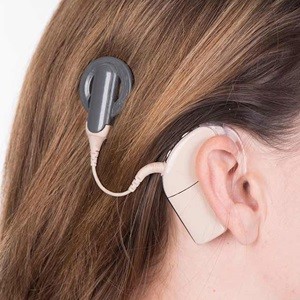Cochlear Implants
Featured Expert:
Cochlear implants are small electronic devices that help people hear sounds. They are for people who have moderate to profound hearing loss.
What You Need to Know
- A cochlear implant has two parts: one worn outside the ear and one that is surgically implanted under the skin behind the ear.
- Cochlear implants use electrodes that extend into the cochlea, a part of the inner ear, to stimulate the nerves that help with hearing.
- A cochlear implant is not a type of hearing aid, which stimulates the ear with amplified acoustic information. Rather, using it is a way for people with significant hearing loss to hear sounds and understand speech via electrical stimulation of the inner ear.
- After getting a cochlear implant, patients must receive activation, programming and rehabilitation to train the brain to recognize speech.
What is a cochlear implant?
Cochlear implants are small electronic devices that allow people to hear sounds. A cochlear implant does not restore normal hearing, but it can help people to understand speech with less reliance on lip reading and to perceive sounds.
A cochlear implant has two main parts:
- One part is outside of the ear. It has a microphone to detect sound, a battery to power the system, a processor to process sound and a transmitter to send the electric signals to the internal part.
- The cochlear implant’s internal part is implanted under the skin, with electrodes (wires) that extend into the cochlea (a structure in the inner ear). The electrodes respond to sound information captured by the outer processor and stimulate the neurons in the cochlea to create a signal that is picked up by the brain.
Cochlear Implant Versus Hearing Aid
A cochlear implant is different than a hearing aid. Hearing aids make sounds louder but rely on the ear’s natural hearing ability, so they may not work well for people with severe hearing loss due to damage in the inner ear (sensorineural hearing loss).
Cochlear implants directly stimulate the part of the ear that doesn’t work by using a mild electrical current applied to the structures in the cochlea. A cochlear implant can help adults and children with severe hearing loss who cannot understand speech even with powerful hearing aids.
How is a cochlear implant inserted?
Cochlear implant surgery is an outpatient procedure performed in a hospital or clinic, with the patient under general anesthesia (asleep). The surgeon makes a small incision behind the ear and places the internal processor in a pocket between muscle and bone. Drilling a small hole, the surgeon gains access to the inner ear and places the electrodes inside the cochlea. Altogether, the process is approximately two hours long.
About three to four weeks after the surgery, the audiologist will activate the cochlear implant’s external parts, which starts electrical stimulation and a new hearing experience for the patient.
How do cochlear implants work?
A cochlear implant electrically stimulates the cochlea, which stimulates the nerve that carries sound to the brain.
When sound is present:
- A microphone inside the external speech processor detects sound and breaks it down into its acoustic components.
- The speech processor relays the coded acoustic information to an external transmitting coil that is behind the ear.
- The coil communicates with the internal processor (via a receiving coil), a part of the device that a surgeon places under the skin.
- The internal processor converts the coded acoustic information into electrical signals and sends them to electrodes inside the cochlea.
- The electrodes stimulate the cochlear structures according to the acoustic information they are trying to convey.
- The hearing nerve sends signals to the brain, which interprets the sounds.
By stimulating the hearing nerve, the cochlear implant can help the person detect sounds. Although these sounds might sound unfamiliar at first, after rehabilitation, most people can train their brain to process the sounds and can learn to understand speech.
Types of Cochlear Implants
A variety of cochlear implant models are available that differ in size, weight, number of electrodes and features.
Although all cochlear implants have parts inside and outside of the ear, in some models, the sound processors are combined into one disk-like piece on the side of the head, with the microphone and transmitter included ― nothing hangs on the ear. A child can use the same implants as adults because the size of internal ear structures does not change with age. An appointment with an audiologist is scheduled before surgery to help you learn about the options and to choose the implant that meets your needs.
Who is a candidate for a cochlear implant?
Cochlear implants are designed for people with moderate to severe sensorineural hearing loss (loss due to damage in the inner ear) who have difficulty interpreting speech even with a hearing aid.
A cochlear implant may be right for those who:
- Struggle to understand speech even with hearing aids that are properly fitted
- Are motivated and have adequate support systems to help them learn to understand sounds and speech with the implant
Determining whether a cochlear implant will help a patient takes a team approach. The doctor may work with other experts and recommend:
- A hearing test (audiogram), with or without hearing devices currently being used
- A CT scan and MRI to examine the inner ear
- Examination by audiologists and other specialists to assess communication abilities
- Tests for balance, since surgery involving the ear can have an impact on balance
Cochlear Implants for Children
Children whose hearing loss is not adequately managed with hearing aids can benefit from cochlear implants. When used starting at a young age, cochlear implants can improve a child’s hearing and ability to understand and use spoken language.
Learn more about cochlear implants for children.
I can’t understand what people say in a large group or noisy situation. Will the cochlear implant fix that?
The simple answer is no. Despite the improvements in hearing from a cochlear implant, you will likely still have difficulty and frustration when listening in large groups or when there is noise. However, over time, your ability to communicate in those situations may become easier as you have greater access to sound information and your brain can ignore some of the noises you don’t want to hear.
The Johns Hopkins Cochlear Implant Center

The Cochlear Implant Center offers a comprehensive approach to cochlear implantation and rehabilitation, including one-on-one therapy to help patients learn to use cochlear implants. We perform hundreds of cochlear implant surgeries each year on adults and children, lead clinical trials and provide state-of-the-art care.
Cochlear Implant Pros and Cons
People with cochlear implants report the following benefits:
- The ability to hear their own voice and improve their voice tone and pronunciation
- Easier communication with friends and family members
- The ability to hear sounds around them for safety and better quality of life
- For babies born with hearing loss or young children with progressive hearing loss, the ability to meet developmental milestones if cochlear implants are used starting at a young age
However, the following points deserve consideration:
- Results vary. Not everyone experiences the same level of improvement in hearing and well-being after a cochlear implant.
- Part of the device is surgically implanted and cannot be removed without further surgery.
- A cochlear implant that fails (this is very rare) must be surgically removed, but usually it can be replaced during the implant procedure.
- The sound experienced with a cochlear implant is different than normal hearing, and the brain needs time to learn how to use the new input.
What is sound like after cochlear implant surgery?
This is a difficult question to answer because, perceived sound quality varies for each person.
At first, people with cochlear implants commonly describe sound as “mechanical,” “robotic,” “cartoonish” and “like people are talking with marbles in their mouth.” Some patients experience only sensations when the implant is first turned on.
Hearing and interpretation of sound involve a complex communication between the ear and the brain. Getting used to the cochlear implant takes a while. Eventually, the sound quality will change as the brain learns the stimulation patterns that the device provides. Most patients notice improving sound quality during the first three to 12 months.
What can you hear with a cochlear implant?
Results for people with a cochlear implant differ widely, from little benefit to almost completely restored hearing. For adults, hearing improves rapidly during the first three months and then levels off, with slower improvement over the next several years. Progress is slower for children, who need to learn language through hearing with the cochlear implant.
Most people can distinguish soft, medium or loud noises, and identify common sounds such as the doorbell, the phone, approaching vehicles and footsteps. Many people can use the telephone and watch and enjoy television.
Patients who have exceptionally good results can hear and appreciate music, with or without headphones, and even discern different instruments. All current cochlear implants can wirelessly stream audio from smartphones and other devices equipped with Bluetooth.
Difficulty will probably remain when listening in large groups or noisy situations that are challenging even for people with full hearing in both ears.
Having a cochlear implant can make it easier to lip read even if hearing does not improve enough so that speech can be understood.







